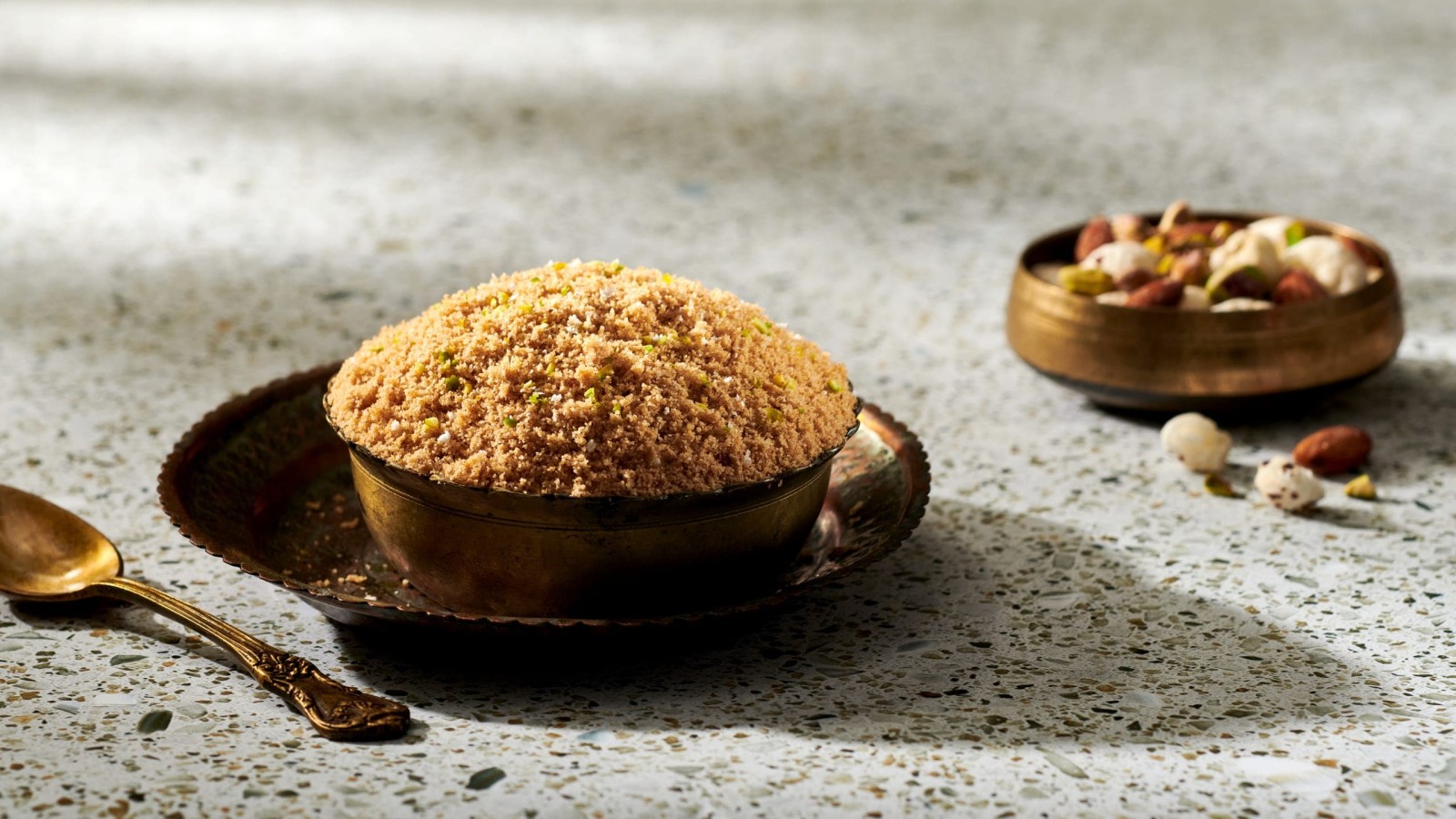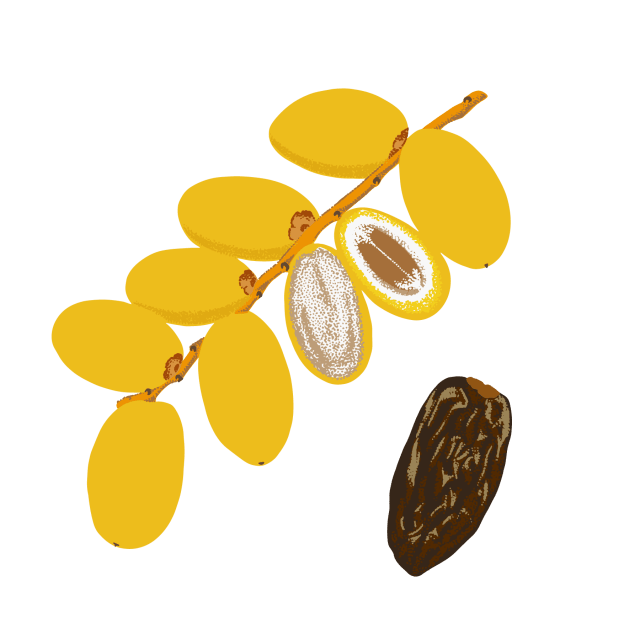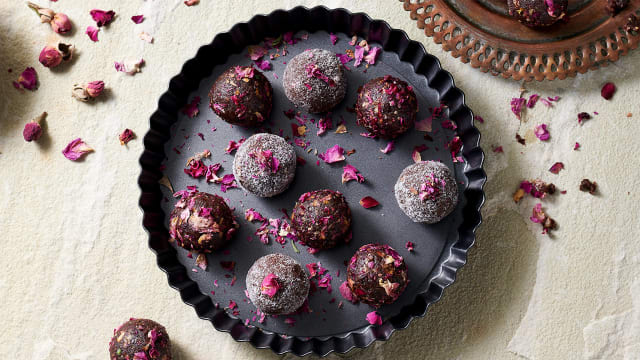Panjiri

Panjiri
Description
A sweet, buttery crumble with nutty notes, think of panjiri as a desi granola. A popular postpartum health mix, this version is from the Karwar region, India. A nutritional supplement of yore, panjiri is great for young children and nursing mothers. A spoonful over breakfast is enough to reap the health benefits of its macro and micronutrients, antioxidants, and bioactive compounds.
Ingredients
30 oz (830 g) MAKES
- 2 Tbsp ghee, plus more as required
- 2/3 cup (3.5 oz/ 100 g) almonds
- 2/3 cup (3.5 oz/ 100 g) cashews
- ¾ cup (3.5 oz/100 g) walnuts
- ¾ cup (3.5 oz/ 100 g) pistachios
- 2/3 cup (3.5 oz/ 100 g) raisins
- 1 cup (3.5 oz/ 100 g) kharik (dried yellow dates), deseeded and quartered vertically
- 4 Tbsp (3.5 oz/ 100 g) gond (gum Arabic)
- 3/5 cup (3.5 oz/ 100 g) fine suji (semolina)
- 2 cups (1.76 oz/ 50 g) makhana (foxnuts)
- 1 to 2 tsp of powdered cardamom (optional)
- 1 to 2 tsp of powdered fennel (optional)
Directions
-
Step 1
Heat 1 Tbsp of ghee in a kadhai or a medium-size pan. Add the almonds and sauté on medium heat, stirring continuously for about 1 to 2 minutes or until they are evenly brown and toasted. Remove the almonds using a slotted spoon, and drain them on a paper towel. Ensure the almonds are spread out, not crowded. In the same pan, one type of nut at a time, toast the cashews, walnuts, and pistachios, each until golden brown and fragrant. Adjust the heat for each nut: Denser and bigger almonds and cashews on medium heat, smaller, more delicate pistachios on low heat. Top up the ghee as needed, 1 tsp at a time, just enough to coat the nuts for even toasting. Drain the nuts on separate plates or a large tray to avoid crowding. This will ensure that they remain crispy. -
Step 2
Sauté the sweeter ingredients, one by one. First, fry raisins on low heat for 2 to 3 minutes, until light golden. Remove with a slotted spoon and drain on a paper towel. Add more ghee, if needed, and shallow fry the kharik on medium heat for 4 to 5 minutes until golden and crisp. Fry the gond, which will puff up, in batches on medium-low heat. Fry a little at a time, remove with a slotted spoon and spread out on a plate to cool down. -
Step 3
Now add the semolina to the same pan and cook for 1 minute on medium-high heat, stirring continuously. Add 1 Tbsp of ghee and continue cooking on medium-low heat for 10 to 12 minutes or until it's golden-brown and fragrant. Stir occasionally to avoid over-browning at the bottom. Turn off the heat and leave the semolina in the pan. For a gluten-free version, replace semolina with bajra (pearl millet) or ragi (finger millet) flour. Chana sattu (roasted chickpea flour) works well, too -
Step 4
Alongside the semolina, set up a large pan or kadhai on the stove to pan roast the foxnuts. Heat 1 tsp of ghee and roast the foxnuts on medium-low heat, occasionally stirring, until they are crisp. To check, pick one and crush it between your fingers. If it crumbles, it's ready. -
Step 5
In a mixer-grinder or a food processor, grind together the almonds, cashews, walnuts, pistachios, raisins, kharik, gond and foxnuts to a fine powder. Depending on the size of your jar, you may need to grind in batches. -
Step 6
Empty the contents into a large bowl. Add the roasted semolina and mix well. You can also add 1 to 2 tsp of powdered cardamom or fennel, but this is entirely optional. Leave it to rest for a few minutes until completely cool. Transfer the panjiri to a bottle or jar with an air-tight lid. Refrigerate for up to three months. This version of panjiri relies on dates and raisins for sweetness. Increase their quantity or add a sweetener of your choice if you’d like it sweeter. You can customize this recipe by adding ingredients such as peanuts, poppy seeds, sesame seeds, and tiny quantities of your preferred spices. Eat a spoon or two straight up every day, or enjoy it in a glass of warm milk or sprinkled over Greek yogurt, porridge, and smoothies.
Explore Recipe Ingredients
About the author
More by Saadia S Dhailey

Ful
Fava bean stew, ful (also known as ful medames) is popular as both a breakfast staple and a dinner entrée in the Middle East. Hole-in-the-wall restaurants serve the best kinds, as they slow-cook the stew the traditional way over embers all night (and day).

Methi Ki Ganji (Fenugreek Gruel)
Along coastal India, new moms are given a sweet and soothing fenugreek and coconut milk gruel to help with their post-partum recovery

Q&A with Dan Buettner
Buettner on the Blue Zones' wisdom:
eat whole foods and taste rules.



